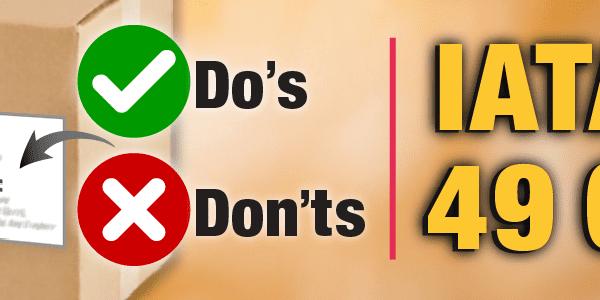Labels, Markings, Placards, and more (OH MY!)
All in “Consolidation Bin” and “Overpack” amendments
As promised late last month, Transport Canada has published the Dangerous Goods Safety Marks (commonly referred to as the “12th”) Amendment to the Transportation of Dangerous Goods regulations (TDGR). The stated purpose of this amendment is to bring the TDGR a little closer to accepted international (UN Model, ICAO, IMDG) and US 49 CFR practices as well as improved communication of hazards to emergency responders. In addition the November 2013 & January 2014 proposed amendments have been issued under the title “Update of Standards”.
These regulations are “in force” on July 14 and 15 (respectively), 2014 – but the regulations existing on the day prior to these dates may continue to be used for 6 months following the “in force” dates.
These changes are arguably the most significant since Amendment 6 – if not since the basic “Clear Language” TDGR.
The TDGR now recognize the 17th (2011) edition of the UN Recommendations (“Orange Book” – despite the existence of the 18th – 2013 Ed.)
Placard Changes:
The current Parts 4.15 & 4.16 have been completely re-written with separate sections added to highlight areas that used to be in the Table to Part 4.15. The new Part 4.16 deals with the revised requirements for Danger placards and the previous “500 kg placarding exemption” is expanded into Part 4.16.1.
The most significant provisions for the average consignor/carrier will probably be the restriction on the use of “Danger” placards to essentially restrict them to consignments of “small means of containment” (smoc – i.e., containers of not more than 450 L capacity); and removal of the option of allowing “Danger” placards for mixed loads of gases. Mixed loads of gases may, if they contain Class 2.3 gases in addition to other classes, display only the Class 2.3 placard.
A section has been added allowing the voluntary display of placards as long as the “rules” are followed.
Multi-compartment tanks with different Class 3 flammable liquids must now have both the UN number of the lowest flash point liquid and UN3475, if it’s present and is not the lowest flash point liquid –on each side and end of the unit.
Shippers of IBC (“intermediate bulk container”) totes, of capacity of 3000 L or less, will now have the option to use just 2 placards, with UN numbers, on opposite sides; OR 1 label, with the UN number and shipping name, on each of 2 opposite sides (instead of the standard 1 placard on each of 4 sides). This will eliminate the need for a plethora of Equivalency Certificates on the subject.
The expected update to the current international Class 5.2, Limited Quantity, Marine Pollutant and Fumigation placards, labels and marks are included. A new requirement to add a sign indicating “Toxic- Inhalation Hazard” or “Poison- Inhalation Hazard” has been added for any shipment of Class 6.1, PG I invoking Special Provision 23.
Limited Quantities:
As well as introducing the “international” limited quantity mark as the sole identifier for limited quantities/consumer commodities (although existing options may also be used until Dec. 31, 2020), the requirement for documenting/reporting spills on consignments of more than 500 kg (gross) has been dropped.
Ovepacks/Consolidation Bins:
In addition to the expected addition of “overpacks” to the TDGR – requiring markings similar to those found in ICAO/IATA, there is a definition added for “consolidation bins”. These are both non-standardized packagings to contain required standardized (i.e., “UN-certified”)” for ease of handling. The difference is essentially the latter are intended to have containers removed at various stops during the course of transportation whereas the former are intended to remain intact to a final destination.
In case of an overpack, the DG safety marks must be visible on at least 1 side (2 opposite sides if the volume capacity is 1.8 cubic meters or more); consolidation bins must be marked or tagged with a list of the hazard class(es) for any labeled packages within.
Proof of Classification/Certification:
As expected following the Lac Megantic report, requirements have been added for the consignor to have documented proof of classification available for 5 years following the date of the shipping document. Concurrent with this the existing provision for reliance on “a previous consignor” or the manufacturer’s classification has been removed. There is some provision in the clarifying text for using an annotated “SDS” as proof.
In the same vein, a requirement has been added to have the shipping document include a “Consignor’s Certification” statement signed by an individual (consignor or the consignor’s representative) that the consignment fully complies with the regulations. Standard wording must be used.
New “TP” Standards:
The proposed Transport Canada standards for small means of containment and rail cars – TP14850 and TP14877 – have been adopted to replace CGSB 43-150 and CGSB 43-147 respectively. These are available for download from the Transport Canada website.
Other Changes:
There are a variety of other changes relating to: always displaying placards on road/rail vehicles with Class 2.1 loads intended to be transported on a ship; recognizing updates to other standards in the Part 1.3.1 Table, and modifying/repealing various Schedule 2 “Special Provisions”.
The full “Part 4, Dangerous Goods Safety Marks” amendment can be found at:
http://www.gazette.gc.ca/rp-pr/p2/2014/2014-07-02/html/sor-dors159-eng.php
The full “Update of Standards” amendment can be found at:
http://www.gazette.gc.ca/rp-pr/p2/2014/2014-07-02/html/sor-dors152-eng.php





